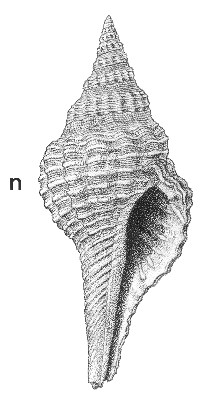
Revised descriptions of New Zealand Cenozoic Mollusca from Beu and Maxwell (1990)

 | Revised descriptions of New Zealand Cenozoic Mollusca from Beu and Maxwell (1990) | 
|
  (Pl. 27n): GS3341, J32/f7585, abandoned brickworks quarry, Karoro, near Greymouth, Westland (Waiauan) (GNS) |
Beu & Maxwell (1990): Chapter 12; p. 249; pl. 27 n.
Synonymy: Euthriofusus tangituensis Marwick 1926c, p. 320; Falsicolus waiauensis Finlay 1930e, p. 265; Falsicolus tangituensis, Beu & Maxwell 1990, p. 249, pl. 27n; Falsicolus (Liracolus) tangituensis, Maxwell 1992, p. 125.
Classification: Fasciolariidae
Description: Size moderate for genus (height 40-70 mm), robust, broadly fusiform, spire 0.3 total height. Protoconch conical, of 3 convex whorls; last quarter-whorl with narrow axial costellae crossed by 4 narrow spiral cords, remainder very finely granulose. Teleoconch of up to 8 whorls, shouldered at or near middle of whorl on spire, sutural ramp concave, particularly on later whorls. Last whorl excavated, with long almost straight neck. Axial sculpture commencing at beginning of teleoconch as rounded costae extending from suture to suture but becoming obsolete on ramp on later whorls; costae varying considerably in strength, in some shells becoming obsolete on last whorl, in others persisting to outer lip; 11-15 costae on penultimate whorl. Spiral sculpture commencing as 3 subequal cords, topmost on shoulder angulation; fine threads appear between primaries and on ramp during growth, last whorl with 13-17 additional cords on base and neck, those on posterior half with interstitial threads. Aperture pyriform, columella bearing weak rounded ridge at inception of long, straight, narrow siphonal canal; outer lip with 8-14 lirae within.
Comparison: Fusinus tangituensis is apparently most closely related to F. eoaffinis (Altonian, Clifden) and F. excellens (Clifdenian, Clifden) but differs in having a less well defined shoulder angulation (and hence more evenly convex teleoconch whorls) and coarser spiral sculpture. Most species of Falsicolus are recorded from probable middle or outer shelf faunules, but F. tangituensis ranged down into the upper bathyal zone (Maxwell 1988a, p. 17). It is the only common large mollusc in the upper part of the Stillwater Mudstone in the Greymouth district. F. waiauensis, from shallow-water assemblages in Southland, does not differ significantly from F. tangituensis (Maxwell 1988a, p. 54-55). This is another member of the group of species discussed under Fusinis bensoni, which all were referred to Falsicous (Liracolus) by Maxwell (1992, p. 125), but subsequently have been referred to Fusinus by Maxwell (2009).
Distribution: Waiauan-Tongaporutuan; Tangitu River, North Taranaki (Tongaporutuan) (type of E. tangituensis); Clifden ("Band 7c", probably Nissen "no. 1" shellbed, Park Bluff, Waiauan) (type of F. waiauensis); common at Karoro Quarry, Greymouth, and nearby Stillwater Mudstone bathyal localities (Waiauan); Kapitea Creek, Westland; Cape Foulwind, Westport (Tongaporutuan).
Cite this publication as: "A.G. Beu and J.I. Raine (2009). Revised
descriptions of New Zealand Cenozoic Mollusca from Beu and Maxwell (1990). GNS
Science miscellaneous series no. 27."
© GNS Science, 2009
ISBN
978-0-478-19705-1
ISSN 1177-2441
(Included with a PDF facsimile file
copy of New Zealand Geological Survey Paleontological Bulletin 58 in CD version
from: Publications Officer, GNS Science, P.O. Box 30368 Lower Hutt, New
Zealand)